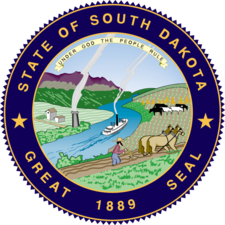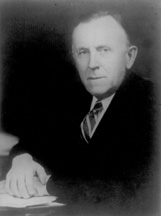Seeing Red: A Brief History of Republican Domination in South Dakota
Republicans are eying to control all partisan statewide elected offices in the Mount Rushmore State for the first time since 1962

Johnson announced his retirement this week, and his party would seem to start in the hole with former Governor Mike Rounds already campaigning for the seat.
Though times may be bleak for Democrats in the Mount Rushmore State, things have been worse.
In fact, aside from a six-year span in the 1930s, the last 50 years have actually been the heyday for the party in South Dakota, when viewed against their struggles over the last century-plus.
However, the tide has turned again in recent years with Republicans winning all eight statewide races in 2010 and three in 2012 to put themselves in a position – with Johnson’s Senate seat now open – to run the table again so that the Democrats would not hold a single partisan statewide office for the first time since 1962.
Overall, during the last 124 years since statehood, Republicans have won 437 of the 525 elections for partisan statewide office, or 83.2 percent.
Democrats have won 83, or 15.8 percent of these contests, with third parties capturing five wins (1 percent).
In the Beginning…
Democrats did not win their first partisan statewide race in South Dakota until a quarter-century after statehood in 1914.
That year Edwin Johnson narrowly won the state’s first direct election for U.S. Senator – beating Charles Burke by 3.9 points in a five-candidate race.
The Republican hold on the state was not absolute during the previous 25 years, however, as third party candidates were elected to various offices during the 1890s (garnering Democratic support with no Democrats on the ballot per se): for Governor (People’s, 1896; Fusion 1898), Attorney General (People’s, 1896), and the U.S. House (People’s, 1896 to the state’s two at-large seats).
Populists and a Silver Republican were also elected to the U.S. Senate during this decade.

Bulow won reelection in 1928, during which the GOP swept the remaining statewide contests, and then appointed a Democrat to the Lieutenant Governor’s office (John Grigsby) after the death of Clarence Coyne in 1929.
Bulow then ousted Republican incumbent William McMaster in the 1930 U.S. Senate race that preceded a slew of Democratic victories in the 1932, 1934, and 1936 cycles – mirroring the political tsunami that was taking place across the country.
Democrats won 18 of 19 statewide races in South Dakota in 1932 and 1934 with the only blemish being the 1932 U.S. Senate race won by two-term GOP incumbent Peter Norbeck.
In 1936, Democrats won the elections for South Dakota Secretary of State, Auditor, Treasurer, Attorney General, Commissioner of School and Public Lands, Superintendent of Public Instruction, and U.S. Senate, but lost races for Governor, Lieutenant Governor, and Railroad Commissioner.
After Bulow lost the 1942 U.S. Senate primary to former Governor Tom Berry – who then lost the seat for the Democrats in November’s general election – Democrats were without a partisan statewide officeholder in 1943.
(The Superintendent of Public Instruction was a non-partisan office at this time, although still held by previously partisan-elected Democrat J.F. Hines).
Over the next seven cycles through the Election of 1956, Republicans won all 61 partisan statewide electoral contests.
Democrats rebounded with five victories in 1958 (Governor, Lieutenant Governor, Secretary of State, Auditor, Attorney General) – a wave election year for the party nationwide – but the only contests won by the party over the next five cycles from 1960 through 1968 were George McGovern’s two U.S. Senate wins in 1962 and 1968.
Modern Times
From 1970 through 2008, Democrats were able to land 47 statewide victories during these 38 years – hardly impressive, but much better than the mere 36 they won during the previous 81 years dating back to statehood:
· Public Utilities Commissioner: 12 cycles (1970, 1972, 1974, 1978, 1982, 1984, 1986, 1990, 1992, 1996, 1998, 2006).
· U.S. House (at-large): 11 (1982, 1984, 1986, 1988, 1990, 1992, 1994, 2004 (special), 2004, 2006, 2008).
· U.S. Senate: 8 (1972, 1974, 1986, 1992, 1996, 1998, 2002, 2008).
· Commissioner of School and Public Lands: 6 (1972, 1974, 1990, 1994, 1998, 2002).
· Governor: 3 (1970, 1972, 1974).
· Lieutenant Governor: 2 (1970, 1972).
· Treasurer: 2 (1994, 1998).
· Secretary of State: 2 (1972, 1974).
· Attorney General: 1 (1972).
The longest current Democratic drought in South Dakota is for the office of State Auditor, for which the party has been shut out since 1958 when Harriet Horning was victorious in one of only four wins for the party in state history for that office.
South Dakota Partisan Statewide Elected Office Since Statehood
|
Office
|
Years
|
GOP
|
DEM
|
3rd
|
Total
|
% GOP
|
|
Commissioner of Labor Statistics
|
1890-1894
|
3
|
0
|
0
|
3
|
100.0
|
|
Auditor
|
1889-present
|
49
|
4
|
0
|
53
|
92.5
|
|
Treasurer
|
1889-present
|
48
|
5
|
0
|
53
|
90.6
|
|
Secretary of State
|
1889-present
|
47
|
6
|
0
|
53
|
88.7
|
|
Attorney General
|
1889-present
|
47
|
5
|
1
|
53
|
88.7
|
|
Lieutenant Governor*
|
1889-1972
|
38
|
5
|
0
|
43
|
88.4
|
|
Superintendent of Public Instruction**
|
1889-1936
|
22
|
3
|
0
|
25
|
88.0
|
|
Commissioner of School & Public Lands
|
1889-present
|
44
|
9
|
0
|
53
|
83.0
|
|
Governor
|
1889-present
|
43
|
8
|
2
|
53
|
81.1
|
|
Public Utilities Commissioner***
|
1898-present
|
46
|
14
|
0
|
60
|
76.7
|
|
US House (At-large)
|
1889-present
|
30
|
11
|
2
|
43
|
69.8
|
|
US Senate
|
1914-present
|
20
|
13
|
0
|
33
|
60.6
|
|
Total
|
437
|
83
|
5
|
525
|
83.2
|
|
* Lieutenant Governor tied to Governor starting in 1974. ** Superintendent of Public Instruction nonpartisan office since 1938. *** Formerly Commissioner of Railroads (Three officials are elected to the commission, usually staggered). Data compiled by Smart Politics with election results provided by the office of the South Dakota Secretary of State.
Follow Smart Politics on Twitter.
